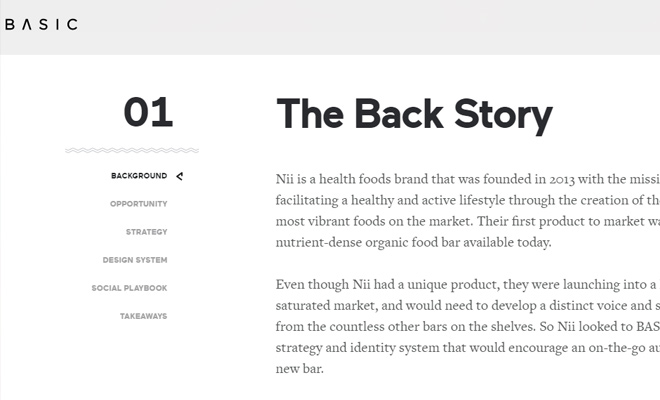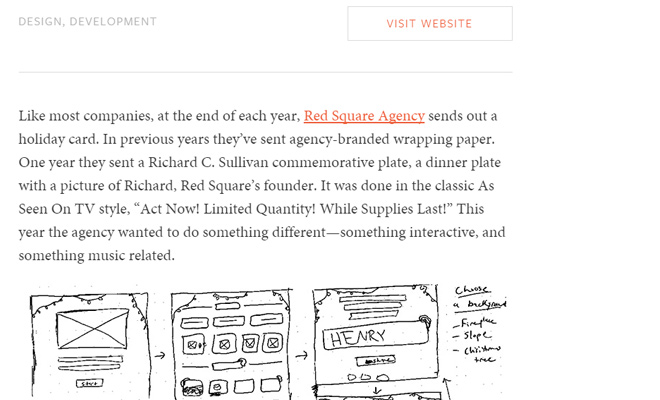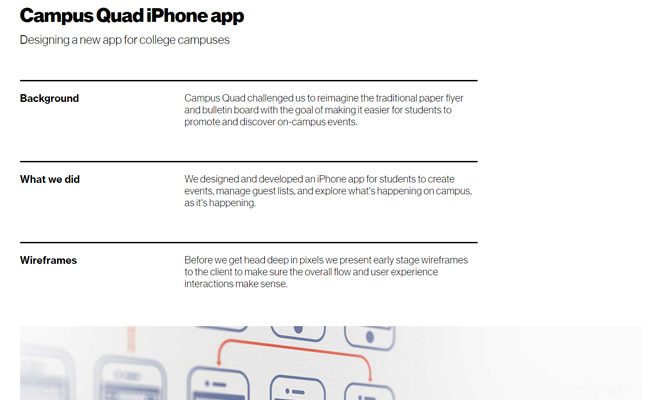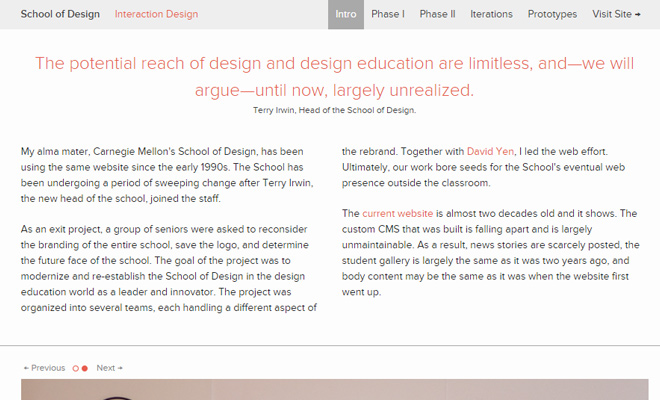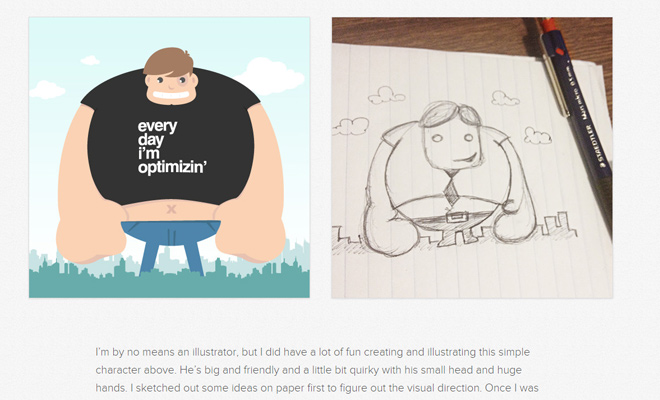Modern case studies are built for design projects of all types. Studios and freelancers alike can put together case studies ranging from branding, web design, mobile UI design, or even After Effects compositing.
The following tips & examples should help you understand the purpose of case studies in a creative portfolio. While they might not be useful for every project, there is drive among designers to fit more case studies into portfolio work. A great case study will demonstrate not just technical proficiency but also a philosophical understanding of design principles.
Case Studies hold Knowledge
When styling a case study it’s a good idea to frame it from an educational perspective. Most portfolio entries include some photos with extra details about the project. This is fine and most definitely encouraged – but case studies are meant to explain the stages and hurdles of a project.
Aside from actual mockups or completed designs you might also include some preliminary photos. Basic prototypes, sketches, or even rejected design ideas. All of these things demonstrate knowledge to prospective clients or job recruiters.
Take a look at the above case study from the portfolio of Jordan Price. His layout is exquisite and touches upon all the main areas of a project. The page includes the overall project goal, initial sketches/prototypes, production graphics, and ultimately the final product.
When you can show your process in this manner it opens up a world of opportunity. Basic portfolio entries might just show a finished project and some basic details. But anyone can show a finished project – people really want to see and learn about your process.
Design interesting case studies to help others understand your creative process. This is not an easy task at first because you probably won’t have much experience describing each project in detail. But with practice it gets a lot easier and really fun.
Take for example the Basic Agency case study which incorporates sectioned areas for content. The project is broken down into phases with photos and descriptions of each one. The case study page uses a sliding navigation element so readers can skip between sections.
A great case study should be written to share & demonstrate knowledge. Keep this in mind at all times and be sure to conserve resources from each stage of a project.
Show your Creativity
Demonstrate your process in a true-to-life manner. Take photographs of sketches on your desk or scan your sketchbook for a digital shot. Take apart your designs and create little diagrams with tooltips going into detail about each part.
Creation is a somewhat elusive concept for non-creative people. Although everyone has creativity we don’t all use creative energy in the same way. So visitors will always be curious to know more about your creative side and how you do the work you do.
The portfolio website of Henry Bayuzick is rather simple yet straightforward. It looks all-business and his case studies come off with a similar vibe. Each page includes plenty of written content but there are sketches and prototypes littered throughout.
It’s always nice to show your creative process in both visual and contextual ways. Before writing a new case study you might take down some notes or even write an outline of each section and how you want the content to flow.
Add Personal Work
Case studies do not always need to rely on client work. It’s actually a smart idea to add case study details about your own personal work or projects you did just for fun.
Most people call this spec work where a creative person makes something on speculation without the guarantee of payment. Sometimes this can be for a project which may sell in the future. Other times it can be for project destined to be a portfolio piece.
Personal work is so important because it’s a way to demonstrate alternate skills which you may still be developing.
For example a talented UI designer may only receive inquiries related to websites and mobile applications. But this designer could also have prowess in another skillset like motion graphic design. So if this person wanted to land motion graphics/compositing work, they should create a demo reel or add some motion project case studies to their portfolio.
You can’t always wait around for the perfect project to fall into your lap. This is especially true if you hope to move into another industry but don’t have any examples of work. Nobody will hire a freelance web designer to do photography if they don’t have any serious work examples.
The moral here is to stay focused on particular areas which you truly enjoy. Show off your best work and prove that you know your stuff.
Details are Everything
The best case studies often take a slant towards being highly-detailed and specific. Before delving into the process most designers will add extra features like tools, techniques, timeframe, clients or even co-workers.
Some details may not be admissible into a public portfolio because of confidentiality agreements. However there are usually lots of details that you can share regarding the specifics of each project in stages. How many iterations did you try before settling on the final one? Which techniques were used to create certain textures?
SFCD has an interesting case study layout which delves into a ton of detail. Their studies includes video media along with sections for project descriptions and client info.
Scrolling down the page you’ll notice individual sections outlining parts of the UI design. Each section behaves like a focus study into areas of design like texture, fonts, icons, color choices, and the overall composition. People may not read all of this stuff but they’ll sure as hell appreciate your level of commitment.
I also enjoy the case study design of Justin Edmund. The whole page feels like a single unified project which includes design phases into the top navigation bar. It scrolls along with links in the header for prototypes and iterations of the final design.
The only time you’re being too detailed is by repeating information or including stuff that has nothing to do with your work. Otherwise detail is highly recommended for every case study.
Why Should People Care?
Before even starting a case study it may help to jot down notes for your desired direction. People will surely love to read about your process, but it also helps to explain things you learned or some of your favorite creative choices.
Give people a reason to care about each case study and they’ll keep reading. Go into detail about how you created a particular icon or a repeating tiled background. Write about how each idea came into being and why it was rejected or accepted.
The portfolio of Adham Dannaway is simply phenomenal and his case studies follow suit. Most of the content in his case studies are taken up by graphics and previews from each project. There are paragraphs explaining things but most of the work speaks for itself.
This example goes to show that you can always focus on writing or design in balance, or switch it up either way. Most people want to see pictures so you really do need to include some behind-the-scenes content.
However if you’re not much of a writer or simply don’t have time then it’s possible to let the content speak for itself.
Haraldur Thorleifsson has a very clean and minimalist portfolio layout his case studies. Each project covers details about different segments of the design along with the team and final result. Haraldur’s minimalist layout retains focus solely on his work and keeps people interested all the way down the page.
Final Thoughts
If you’re thinking of redesigning your own portfolio consider first taking notes and getting a serious organized plan. Case studies are very popular in the creative field because they demonstrate progress and the ability to create something from nothing. Prospective companies and clients like to see this kind of stuff to be sure that you’re trustworthy on a creative project. If you decide to follow this route be sure to catalog your work and plan a layout structure for organizing detailed case studies into your portfolio.


